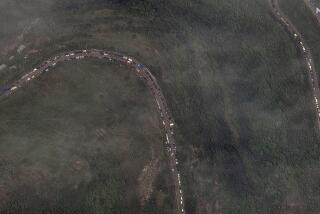Thousand Oaks Man’s Film on Massacre Blocked : Documentary: State educators who commissioned ‘The Armenian Genocide’ project refuse to permit its release to the classrooms.
- Share via
The state Department of Education paid a Thousand Oaks man $50,000 to make a documentary on the massacre of Armenians by the Turks earlier this century but has refused to distribute the film to state schools.
Education officials have expressed concerns about both alleged interference from the Legislature and the quality of the film.
J. Michael Hagopian, who was born in Turkish Armenia in 1913, the son of a well-known surgeon, has been nominated twice for Emmy awards for his earlier films on the subject. But because of a dispute with the state Education Department, Hagopian’s latest film may never reach its intended audience--California’s junior and senior high students.
“The Armenian Genocide” tells the story of the massacre of perhaps as many as 1.5 million Armenians from 1915 to 1923 in what was then the Ottoman Empire. The film, which took two years to make and was completed at the end of 1990, includes interviews with survivors, grisly black-and-white photos of dead children, and student discussions of how such a tragedy could be prevented in the future.
The 25-minute film shows mass deportations, forced marches and starvation. One survivor tells the story of her father’s death at the hands of Turkish soldiers. Her brother, she says, was able to retrieve only his father’s head because the rest of the corpse had been eaten by dogs.
“When I was 2 years old my parents considered hiding me in a well because they feared the family would be killed,” Hagopian said.
But his family escaped, Hagopian believes, because his father’s skills as a surgeon were valuable to the Turks.
Turkish officials reject the accusations that more than a million Armenians were slaughtered, saying that perhaps 300,000 died during the mass deportations. They argue that both Turks and Armenians were victims of a civil war, famine and epidemic that plagued the country between 1915 and 1923.
A state law passed in 1987 required the Department of Education to produce a film on the topic and one on the World War II internment of Japanese Americans for use in state schools. The law, sponsored by former Assemblyman Mike Roos (D-Los Angeles), required schools to include discussion of issues such as genocide in their curriculum.
The Education Department opposed the mandate, just as it would resist any effort by the Legislature to require that certain texts or other instructional materials be used, department spokeswoman Susie Lange said in a recent interview.
“It’s inappropriate for the state Legislature to mandate the making of movies,” Lange said. “To say, ‘You shall develop a movie and this will be the movie (used in classrooms)’ is poor education.”
The Japanese-American internment film was reviewed last year by the department’s curriculum commission but not endorsed for use by California schools because of concern over its content, said Jerry Cummings, consultant in the department’s materials and textbook office.
Hagopian’s film was never reviewed by the commission because it did not meet its deadline, which was moved up after his contract was signed, Education Department officials said.
Also, officials within and outside the department reviewed early versions of the film and determined that more money would have to be spent to make the movie good enough for use in schools, Lange said.
She said officials had questions about the film’s historical accuracy and ability to keep the interest of junior and senior high students.
Hagopian, 77, sees his film as a worthwhile educational tool.
He has made dozens of other documentary and educational films, primarily on ethnic cultures and developing countries.
His first film on the Armenian genocide, “Where Are My People?” was made in 1965 and aired the same year on KCOP-TV. “The Forgotten Genocide,” his 1975 production marking the 60th anniversary of the massacre, also aired on KCOP and was nominated for two Emmy awards.
And he’s not giving up on this one.
Hagopian said he plans to put pressure on the full curriculum commission to review the final version of the film, which contains footage of interviews with 325 survivors of the massacre, many of whom have since died.
“When I look at it, I often get emotional,” he said. “I had hoped it would reach a lot of students. I had hoped it would arouse a lot of discussion and questions.”
More to Read
Sign up for Essential California
The most important California stories and recommendations in your inbox every morning.
You may occasionally receive promotional content from the Los Angeles Times.













